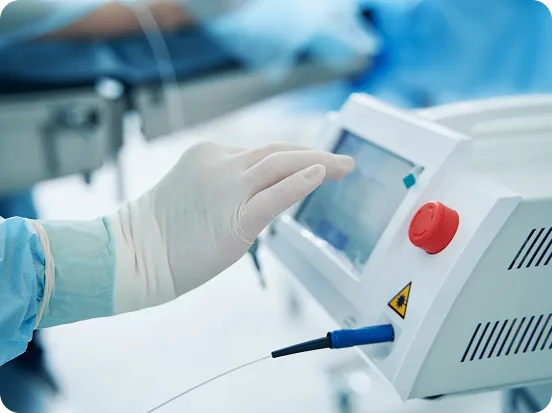Radiofrequency Neuroablation
Minimally invasive relief for long-term pain control.

What Is Radiofrequency Neuroablation?
Radiofrequency Neuroablation (RFA) is a minimally invasive procedure that uses heat generated by radiofrequency waves to disrupt pain signals at their source. By targeting specific nerves, this technique offers long-lasting relief for chronic pain conditions without the need for surgery or opioids.
At Spinal Diagnostics, we use this advanced technique as part of a personalized treatment plan for patients with ongoing back, neck, or nerve-related pain.
What Is Radiofrequency Neuroablation?
Radiofrequency Neuroablation (RFA) is a minimally invasive procedure that uses heat generated by radiofrequency waves to disrupt pain signals at their source. By targeting specific nerves, this technique offers long-lasting relief for chronic pain conditions without the need for surgery or opioids.
At Spinal Diagnostics, we use this advanced technique as part of a personalized treatment plan for patients with ongoing back, neck, or nerve-related pain.

How It Works
The procedure works by generating heat through a specialized needle placed near the affected nerve. The heat creates a small lesion that blocks the nerve’s ability to transmit pain signals to the brain.
It’s performed under local anesthesia and guided by imaging technology to ensure precision.
Conditions Treated with RFA
Radiofrequency neuroablation is especially helpful for chronic pain that hasn’t responded to other treatments. Common conditions include:
Chronic Back Pain
Pain that lasts for more than three months, often affecting the lower back or legs.
Complex Regional Pain Syndrome (CRPS)
A chronic pain condition typically affecting arms or legs, often with swelling, color changes, or temperature sensitivity.
Sacroiliac Joint Pain
Discomfort in the joints connecting your pelvis to the base of your spine.
Peripheral Neuropathy
Nerve damage causing pain, numbness, or weakness in your limbs.
What to Expect During the Procedure
01 Before the Procedure
✔ Your doctor will review your medical history, symptoms, and imaging to confirm if RFA is the right choice.
✔ You’ll receive instructions about medications and transportation (you shouldn’t drive after the procedure).
02 During the Procedure
✔ Local anesthesia is applied to numb the site.
✔ A thin electrode needle is inserted near the targeted nerve.
✔ A stimulation test ensures correct needle placement.
✔ Radiofrequency waves are delivered to create a thermal lesion on the nerve.
✔ The area is cleaned and bandaged.
03 After the Procedure
✔ You’ll be monitored briefly before heading home.
✔ Temporary symptoms like numbness, soreness, or bruising may occur.
✔ Most patients resume normal activities within a few days.
Benefits of Radiofrequency Neuroablation
Radiofrequency Neuroablation offers a safe and effective alternative for patients living with persistent pain. By targeting the source of the problem, this minimally invasive procedure delivers meaningful, lasting results without the risks of surgery or dependence on medication.
Some of the key benefits include:
Long-Lasting Relief
Results may last months or even years.
Faster Recovery
Compared to surgery, RFA offers quicker healing and minimal downtime.
Opioid-Free Approach
Reduces or eliminates the need for pain medication.
Improved Mobility
Many patients return to daily activities with greater ease and comfort.

Care That’s Close to Home
We offer care from two convenient clinic locations, making it easy to access expert medical support close to home.
Each facility is designed to provide a welcoming, safe, and efficient environment equipped with advanced technology and supported by a compassionate team dedicated to your well being.
Care That’s Close to Home
We offer care from two convenient clinic locations, making it easy to access expert medical support close to home.
Each facility is designed to provide a welcoming, safe, and efficient environment equipped with advanced technology and supported by a compassionate team dedicated to your well being.

Why Choose Spinal Diagnostics?
Patients choose Spinal Diagnostics for our comprehensive approach, accurate diagnostics, and compassionate care. We stay at the forefront of interventional procedures and are committed to improving your quality of life without opioids or invasive surgeries.
Proven Medical Expertise
We bring years of clinical experience in pain management and interventional procedures.
Constant Innovation
We use the latest techniques and technology to ensure safe, effective treatment.
Compassionate Care
We listen, understand, and treat every patient with empathy and respect.
Personalized Plans
Each treatment is tailored to your condition, goals, and lifestyle.
Discover what's behind your pain.
Explore the conditions we treat and find the answers you’ve been looking for.
Discover what's behind your pain.
Explore the conditions we treat and find the answers you’ve been looking for.


